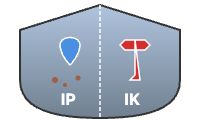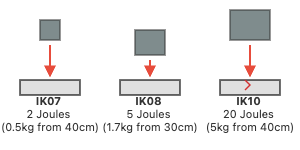Not Just a Numbers Game: A Deep Dive into the Dustproof, Waterproof, and Reinforcement Technologies Behind IP and IK Ratings
Hello everyone. In my 15 years as a global Field Application Engineer (FAE), I’ve seen this scenario countless times: a powerful HMI (Human-Machine Interface) performs flawlessly in the showroom but repeatedly fails in the customer’s factory. Sometimes, a high-pressure water jet used for cleaning causes water to seep into the screen. Other times, dust from the production line infiltrates the device, causing an internal short circuit. I even recall an incident where a screen on a public kiosk shattered after an accidental impact.
These expensive lessons all point to a critical area that many overlook: physical protection design. The standards that quantify this protective capability are the IP and IK ratings we often see on product specification sheets.
Today, I won’t just skim the surface by explaining what these numbers mean. I’m taking you “behind the scenes” to explore the immense effort engineers invest in structural design, material science, and manufacturing processes to achieve these ratings. This isn’t just about standards; it’s about the “silent promise” of product reliability.

1. Decoding IP Ratings: The “Protective Shield” Against Dust and Water
The IP rating, or Ingress Protection Rating, comes from the International Electrotechnical Commission (IEC) standard 60529. It uses two digits to clearly define an enclosure’s ability to protect against the intrusion of solid foreign objects and liquids.
The First Digit: Dust Protection (0-6)
This number indicates the enclosure’s ability to resist solid objects, from a hand to microscopic dust.
- IP0X: No protection.
- IP4X: Protects against objects larger than 1.0mm (e.g., most wires, tools).
- IP5X: Dust Protected. Cannot completely prevent dust ingress, but the amount that enters will not interfere with the device’s normal operation. This is a baseline for many indoor industrial control cabinets.
- IP6X: Dust Tight. Completely prevents any dust from entering. This is the only choice for high-dust environments like flour mills, woodworking factories, or deserts.
The Second Digit: Water Protection (0-8)
This number measures the enclosure’s ability to resist liquid ingress, with increasingly stringent test conditions.
- IPX4: Splashing Water. Can withstand water splashes from any direction. Suitable for semi-outdoor environments that may be exposed to rain.
- IPX5: Water Jets. Can withstand low-pressure water jets from any direction. Suitable for scenarios requiring routine washing with a hose.
- IPX6: Powerful Water Jets. Can withstand high-pressure water jets. This is a mandatory requirement for industries like food and beverage or pharmaceuticals, which require frequent, high-intensity sanitation.
- IPX7: Temporary Immersion. The device can be immersed in water under specified pressure and time conditions (typically 1 meter deep for 30 minutes) without water ingress.
- IPX8: Continuous Immersion. Can be submerged for long periods under conditions specified by the manufacturer, which are more severe than IPX7. Suitable for underwater equipment or marine applications.
Key Takeaway: An HMI rated IP65 is “completely dust-tight and can withstand low-pressure water jets.” An IP67 device builds on this by also being able to withstand accidental temporary immersion.
2. Decoding IK Ratings: The “Suit of Armor” for Structural Strength
The IK rating, derived from the European standard EN 62262, quantifies an enclosure’s resistance to external mechanical impacts. The impact energy is measured in Joules (J).
- IK00: No protection.
- IK07: 2 Joules Impact. Equivalent to the energy of a 0.5kg mass dropped from a height of 40cm. This is the baseline for most standard industrial environments, capable of withstanding accidental bumps from tools.
- IK08: 5 Joules Impact. Equivalent to a 1.7kg mass dropped from 30cm. This is a common rating for rugged HMIs.
- IK10: 20 Joules Impact. Equivalent to a 5kg mass dropped from 40cm. This is the “pinnacle” of protection, typically used for vandal-proof applications like public self-service terminals, prisons, or transportation systems.
3. Behind the Scenes: The Engineering Art of High Protection
Behind these numbers lies a fusion of clever engineering design and material science.
3.1 Achieving High IP Ratings with Sealing Technology
The art of sealing is creating an impenetrable barrier, which is often the weakest link in a system.
- Structural Design is Fundamental: High-protection enclosures often use a “Tongue and Groove” design. The edges of the casing feature a raised “tongue” and a recessed “groove” where the gasket is seated. When the enclosure is closed, this structure provides uniform, precise compression on the gasket and protects it from lateral shear forces, significantly enhancing long-term sealing reliability.

- Gasket Material is the Soul:
- Silicone: Offers excellent resistance to high and low temperatures (-60°C to 200°C) and UV radiation, making it ideal for outdoor equipment.
- EPDM (Ethylene Propylene Diene Monomer): Boasts superior resistance to water, steam, and chemicals, making it the top choice for food processing and chemical industries.
- Polyurethane (PU): Often used in a Form-in-Place Foam Gasket (FIPFG) process. A robot precisely applies liquid polyurethane into the enclosure’s groove, where it foams and cures in place to form a seamless, perfect gasket. This eliminates the potential leakage risks found at the corners of traditional die-cut gaskets.
- Interfaces and Connectors are the Achilles’ Heel: Any opening is a potential leak point. To achieve a high IP rating for the entire machine, one must use equally high-rated waterproof connectors (like M12 circular connectors), waterproof buttons, and cable glands.
3.2 Achieving High IK Ratings with Reinforcement Technology
Boosting strength depends on reinforcing both the “bones” and the “skin” of the device.
- Strong “Bones” – Enclosure Material and Thickness: The material and thickness of the enclosure are fundamental. Die-cast Aluminum or Stainless Steel are common choices for achieving IK08 and above due to their high strength and rigidity. Increasing material thickness and adding internal reinforcement ribs can effectively disperse and absorb impact energy.
- Tough “Skin” – Display Cover Lens: For an HMI, the most vulnerable area is the front display. A reinforced cover lens is key:
- Increased Glass Thickness: Upgrading from a standard 1.1mm or 1.8mm cover glass to 3mm or even 6mm is the most direct way to improve impact resistance.
- Chemically Strengthened Glass: Using technology similar to Corning® Gorilla® Glass, an ion-exchange process creates a compressive stress layer on the glass surface, multiplicatively increasing its strength and scratch resistance.
- The Hidden Advantage of Optical Bonding: This technology does more than just improve sunlight readability. The optical adhesive that fills the gap between the cover lens and the LCD also acts as a shock absorber. More importantly, it bonds the cover lens and the LCD module into a single, solid unit, dramatically enhancing the structural integrity of the entire display assembly and working wonders for improving the IK rating.

4. The FAE’s Field-Tested Selection Matrix
In your projects, you don’t always need to chase the highest rating. Over-engineering means unnecessary costs. Here is a selection matrix I’ve compiled based on my global project experience:

| Application Scenario | Typical Environment & Risks | Recommended IP Rating | Recommended IK Rating | FAE’s Rationale |
|---|---|---|---|---|
| Indoor Clean Control Room | Dust only, no liquid risk. | IP52 | IK06 | Basic dust and drip protection is sufficient for a controlled environment and minor operator errors. |
| Food & Pharma Plants | High-pressure water jets, chemical sanitizers. | IP66 / IP69K | IK08 | Must withstand harsh daily cleaning. IP69K is the top standard for high-temp, high-pressure jets. IK08 resists accidental impacts from tools. |
| Outdoor Public Kiosk | Wind, rain, dust, public contact, vandalism. | IP65 | IK10 | IP65 is sufficient for all weather conditions. IK10 is a mandatory “vandal-proof” spec to ensure the long-term availability of public facilities. |
| Heavy Machinery Cabin | Severe vibration, mud, oil, tool impacts. | IP67 | IK08 | IP67 ensures internal components are safe during harsh weather or accidental submersion. IK08 handles bumps and tool impacts inside the cabin. |
Conclusion: Look Beyond the Numbers, Understand the Engineering, and Make a Wise Investment
IP and IK ratings are far from being just cold numbers on a spec sheet. They are a testament to the manufacturer’s investment in structural design, material science, and precision manufacturing. They are your guarantee that a device can operate reliably for the long term in a demanding environment.
As a decision-maker, your task is to deeply understand the real-world environmental risks your equipment will face and weigh them against your budget and acceptable failure rates. Choosing an under-protected product is planting a seed for future downtime and repairs; choosing an over-engineered, expensive one is a waste of resources.
The next time you evaluate an HMI, be sure to ask: “How exactly did your company achieve this IP/IK rating?” The depth of the answer will directly reflect the supplier’s level of professionalism.
